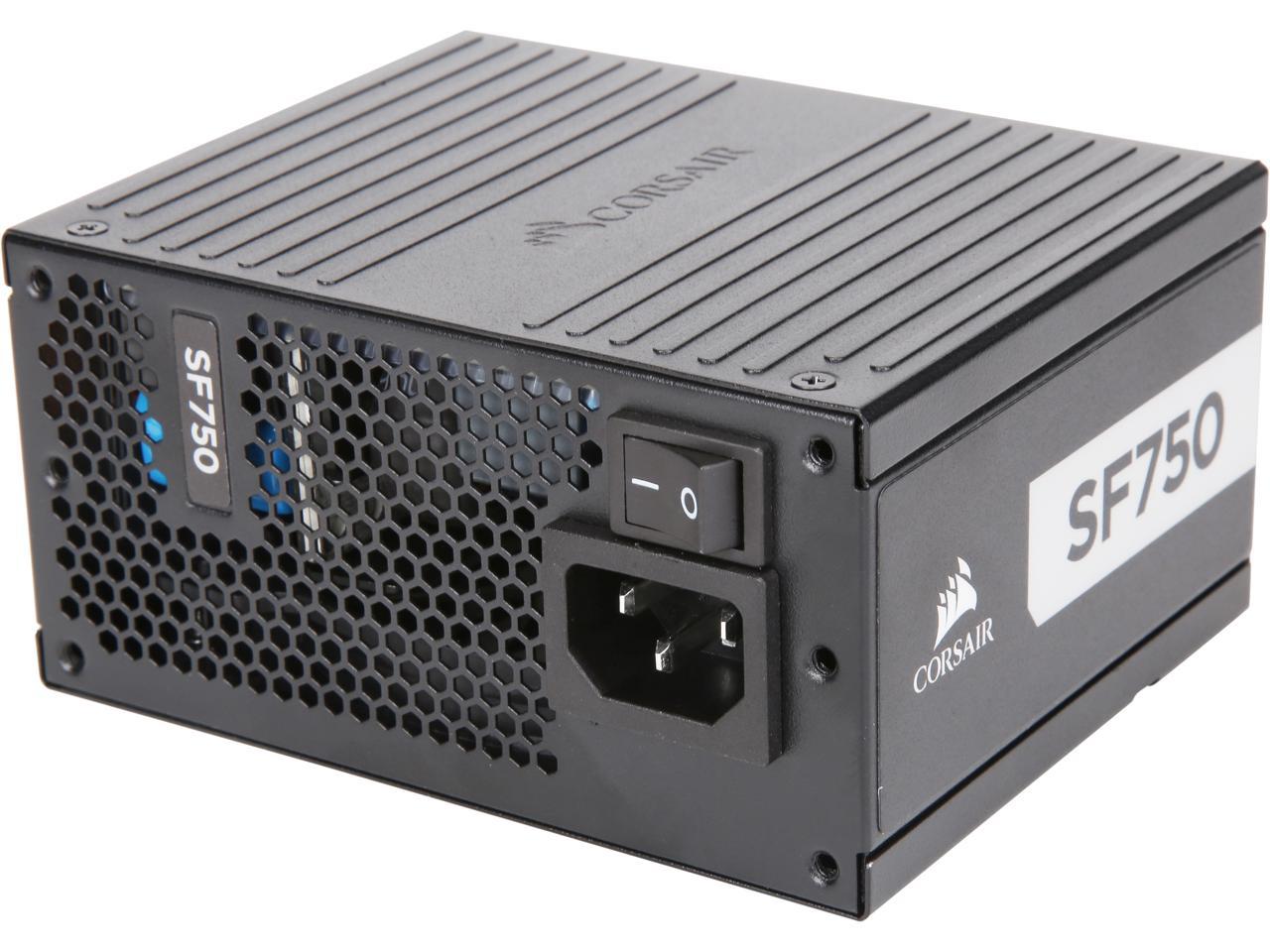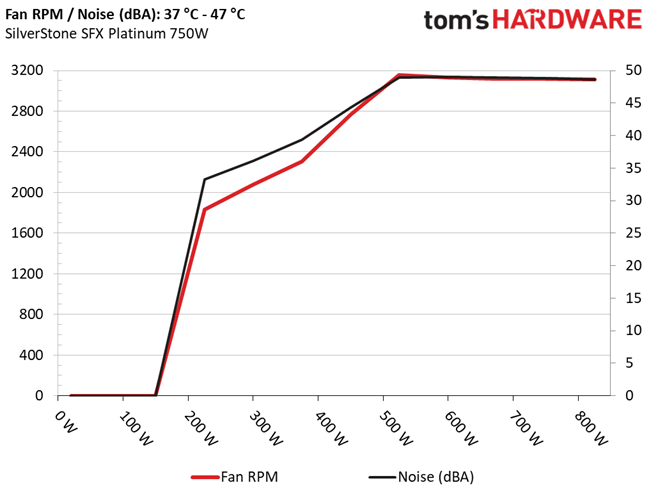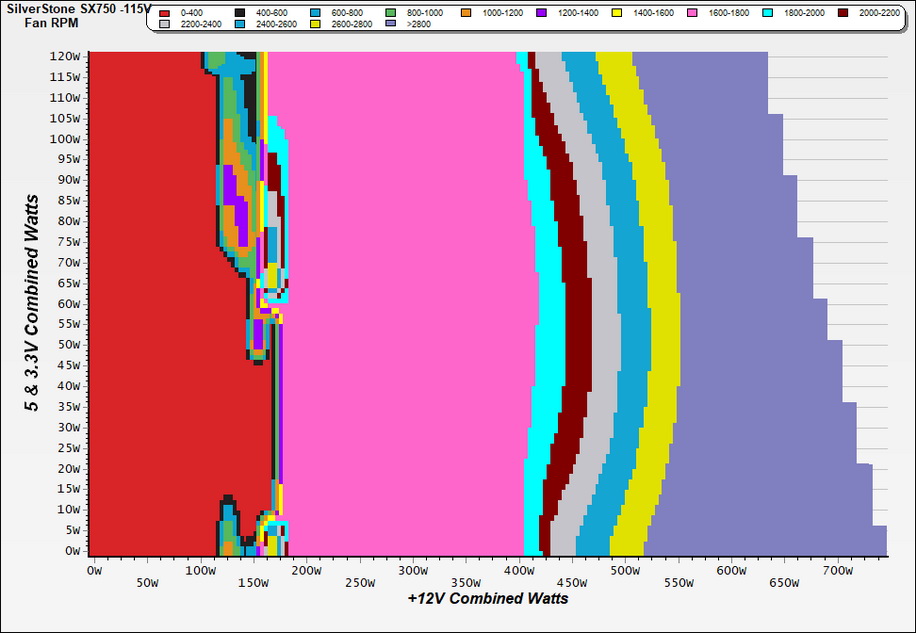Why you can trust Tom's Hardware
To learn more about our PSU tests and methodology, please check out How We Test Power Supply Units.
Primary Rails And 5VSB Load Regulation
The following charts show the main rails' voltage values recorded between a range of 40W up to the PSU's maximum specified load, along with the deviation (in percent). Tight regulation is an important consideration every time we review a power supply because it facilitates constant voltage levels despite varying loads. Tight load regulation also, among other factors, improves the system’s stability, especially under overclocked conditions and, at the same time, it applies less stress to the DC-DC converters that many system components utilize.

Results 1-8: Load Regulation







Load regulation is satisfactory at 12V, but we cannot state the same for the minor rails.
Hold-Up Time
Put simply; hold-up time is the amount of time that the system can continue to run without shutting down or rebooting during a power interruption.

Results 9-12: Hold-Up Time



The hold-up time is extremely short. The power ok signal is accurate, at least.
Inrush Current
Inrush current, or switch-on surge, refers to the maximum, instantaneous input current drawn by an electrical device when it is first turned on. A large enough inrush current can cause circuit breakers and fuses to trip. It can also damage switches, relays, and bridge rectifiers. As a result, the lower the inrush current of a PSU right as it is turned on, the better.

Results 13-14: Inrush Current

The inrush current is on the high side, with 230V input.
Get Tom's Hardware's best news and in-depth reviews, straight to your inbox.
Leakage Current
In layman's terms, leakage current is the unwanted transfer of energy from one circuit to another. In power supplies, it is the current flowing from the primary side to the ground or the chassis, which in the majority of cases is connected to the ground. For measuring leakage current, we use a GW Instek GPT-9904 electrical safety tester instrument.
The leakage current test is conducted at 110% of the DUT's rated voltage input (so for a 230-240V device, we should conduct the test with 253-264V input). The maximum acceptable limit of a leakage current is 3.5 mA and it is defined by the IEC-60950-1 regulation, ensuring that the current is low and will not harm any person coming in contact with the power supply's chassis.

Leakage current is low and at the same level with the SX1000 Platinum.
10-110% Load Tests
These tests reveal the PSU's load regulation and efficiency levels under high ambient temperatures. They also show how the fan speed profile behaves under increased operating temperatures.
| Test # | 12V | 5V | 3.3V | 5VSB | DC/AC (Watts) | Efficiency | Fan Speed (RPM) | PSU Noise (dB[A]) | Temps (In/Out) | PF/AC Volts |
| 1 | 4.384A | 1.950A | 1.986A | 0.983A | 74.967 | 84.855% | 0 | <6.0 | 45.30°C | 0.813 |
| 12.172V | 5.127V | 3.325V | 5.090V | 88.347 | 40.26°C | 115.19V | ||||
| 2 | 9.802A | 2.932A | 2.991A | 1.183A | 150.054 | 88.506% | 0 | <6.0 | 46.21°C | 0.990 |
| 12.156V | 5.114V | 3.312V | 5.073V | 169.541 | 40.40°C | 115.18V | ||||
| 3 | 15.575A | 3.431A | 3.504A | 1.384A | 225.054 | 89.577% | 1830 | 33.3 | 41.97°C | 0.995 |
| 12.135V | 5.100V | 3.297V | 5.058V | 251.242 | 48.06°C | 115.15V | ||||
| 4 | 21.356A | 3.932A | 4.019A | 1.587A | 300.061 | 90.398% | 2077 | 36.1 | 42.15°C | 0.997 |
| 12.121V | 5.087V | 3.285V | 5.041V | 331.932 | 49.04°C | 115.18V | ||||
| 5 | 26.764A | 4.929A | 5.046A | 1.792A | 374.656 | 90.323% | 2303 | 39.4 | 42.33°C | 0.998 |
| 12.111V | 5.074V | 3.271V | 5.023V | 414.795 | 49.51°C | 115.18V | ||||
| 6 | 32.224A | 5.931A | 6.081A | 1.998A | 449.555 | 89.898% | 2766 | 44.3 | 42.74°C | 0.999 |
| 12.095V | 5.059V | 3.256V | 5.005V | 500.073 | 50.43°C | 115.19V | ||||
| 7 | 37.736A | 6.940A | 7.126A | 2.206A | 524.892 | 89.174% | 3159 | 48.9 | 43.24°C | 0.999 |
| 12.078V | 5.045V | 3.242V | 4.987V | 588.616 | 51.51°C | 115.20V | ||||
| 8 | 43.259A | 7.956A | 8.179A | 2.416A | 600.221 | 88.596% | 3130 | 49.0 | 43.93°C | 0.999 |
| 12.062V | 5.031V | 3.228V | 4.968V | 677.483 | 52.84°C | 115.19V | ||||
| 9 | 49.157A | 8.473A | 8.712A | 2.423A | 674.746 | 87.994% | 3121 | 48.9 | 44.13°C | 1.000 |
| 12.048V | 5.016V | 3.214V | 4.953V | 766.809 | 53.61°C | 115.19V | ||||
| 10 | 54.854A | 9.000A | 9.285A | 3.047A | 749.997 | 87.080% | 3118 | 48.8 | 45.44°C | 1.000 |
| 12.037V | 5.001V | 3.199V | 4.925V | 861.272 | 55.58°C | 115.18V | ||||
| 11 | 61.191A | 9.023A | 9.319A | 3.055A | 825.229 | 86.267% | 3113 | 48.6 | 46.97°C | 1.000 |
| 12.020V | 4.988V | 3.187V | 4.912V | 956.604 | 57.83°C | 115.24V | ||||
| CL1 | 0.117A | 14.001A | 13.999A | 0.000A | 118.688 | 82.356% | 3109 | 48.5 | 42.57°C | 0.986 |
| 12.157V | 5.096V | 3.280V | 5.072V | 144.116 | 49.41°C | 115.17V | ||||
| CL2 | 62.560A | 0.999A | 0.999A | 1.000A | 766.077 | 87.711% | 3122 | 48.9 | 45.85°C | 1.000 |
| 12.034V | 5.021V | 3.227V | 4.990V | 873.409 | 55.48°C | 115.19V |
PF readings are extremely high with 115V input. However, we don't frequently see perfect PF scores (1.000). Moreover, the PSU can handle increased operating temperatures, but the output noise is high since the 92mm fan has to spin at high speeds to cope with the thermal load.
20-80W Load Tests
In the following tests, we measure the PSU's efficiency at loads significantly lower than 10% of its maximum capacity (the lowest load the 80 PLUS standard measures). This is important for representing when a PC is idle with power-saving features turned on.
| Test # | 12V | 5V | 3.3V | 5VSB | DC/AC (Watts) | Efficiency | Fan Speed (RPM) | PSU Noise (dB[A]) | PF/AC Volts |
| 1 | 1.219A | 0.487A | 0.496A | 0.195A | 19.994 | 57.229% | 0 | <6.0 | 0.493 |
| 12.172V | 5.140V | 3.336V | 5.119V | 34.937 | 115.17V | ||||
| 2 | 2.439A | 0.972A | 0.991A | 0.392A | 39.985 | 79.617% | 0 | <6.0 | 0.617 |
| 12.172V | 5.135V | 3.332V | 5.111V | 50.222 | 115.18V | ||||
| 3 | 3.661A | 1.463A | 1.487A | 0.588A | 60.016 | 83.498% | 0 | <6.0 | 0.746 |
| 12.172V | 5.130V | 3.328V | 5.102V | 71.877 | 115.18V | ||||
| 4 | 4.878A | 1.952A | 1.985A | 0.785A | 79.965 | 85.466% | 0 | <6.0 | 0.844 |
| 12.169V | 5.127V | 3.324V | 5.094V | 93.563 | 115.18V |
The fan doesn't spin at light loads, even with temperatures exceeding 35 degrees Celsius. The efficiency levels are not high, though, in the first two tests.
2% or 10W Load Test
Intel plans on raising the ante at efficiency levels under ultra-light loads. So from July 2020, the ATX spec will require 70% and higher efficiency with 115V input. The applied load is only 10W for PSUs with 500W and lower capacities, while for stronger units we dial 2% of their max-rated-capacity.
| Test # | 12V | 5V | 3.3V | 5VSB | DC/AC (Watts) | Efficiency | Fan Speed (RPM) | PSU Noise (dB[A]) | PF/AC Volts |
| 1 | 1.064A | 0.245A | 0.246A | 0.051A | 15.286 | 49.993% | 0 | <6.0 | 0.448 |
| 12.165V | 5.141V | 3.337V | 5.123V | 30.576 | 115.18V |
The PSU scores bottom low efficiency, with 2% of its max-rated capacity load. Obviously, burst mode is not utilized to achieve high efficiency at super light loads.
Efficiency & Power Factor
Next, we plotted a chart showing the PSU's efficiency at low loads, and loads from 10 to 110% of its maximum rated capacity. The higher a PSU’s efficiency, the less energy goes wasted, leading to a reduced carbon footprint and lower electricity bills. The same goes for Power Factor.

Results 15-18: Efficiency





The efficiency levels are not high, especially with 2% load. Enhance needs to make some modifications to this platform for higher efficiency.
5VSB Efficiency
| Test # | 5VSB | DC/AC (Watts) | Efficiency | PF/AC Volts |
| 1 | 0.100A | 0.513 | 70.759% | 0.050 |
| 5.124V | 0.725 | 115.18V | ||
| 2 | 0.250A | 1.281 | 78.205% | 0.108 |
| 5.121V | 1.638 | 115.18V | ||
| 3 | 0.550A | 2.814 | 81.025% | 0.201 |
| 5.115V | 3.473 | 115.17V | ||
| 4 | 1.000A | 5.107 | 82.691% | 0.287 |
| 5.106V | 6.176 | 115.17V | ||
| 5 | 1.500A | 7.646 | 82.517% | 0.343 |
| 5.096V | 9.266 | 115.17V | ||
| 6 | 3.000A | 15.199 | 81.474% | 0.423 |
| 5.066V | 18.655 | 115.15V |
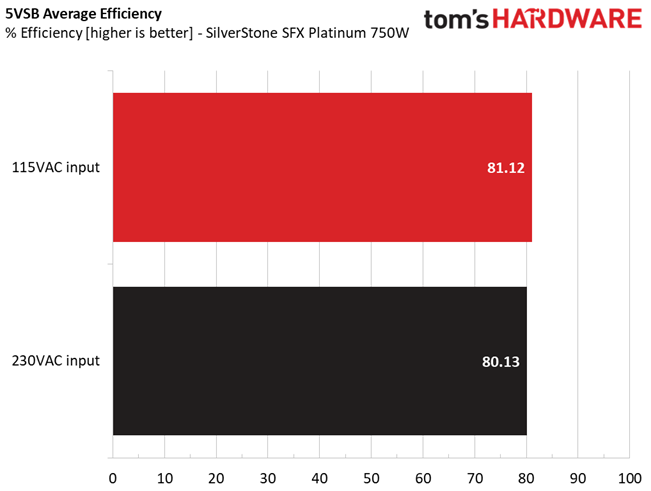
Results 19-20: 5VSB Efficiency
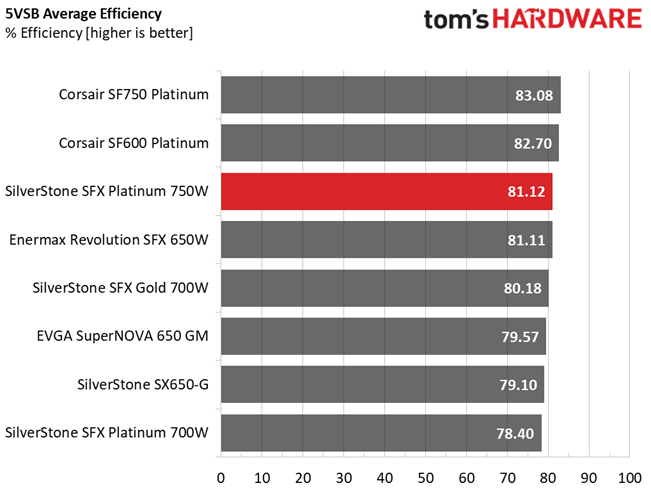
The 5VSB rail is highly efficient!
Power Consumption In Idle And Standby
| Mode | 12V | 5V | 3.3V | 5VSB | Watts | PF/AC Volts |
| Idle | 12.161V | 5.142V | 3.338V | 5.127V | 0.025 | 0.002 |
| 115.2V | ||||||
| Standby | 0.098 | 0.007 | ||||
| 115.2V |

Results 21-22: Vampire Power

Vampire power is a bit on the high side, but still way below the 0.25W limit.
Fan RPM, Delta Temperature, and Output Noise
All results are obtained between an ambient temperature of 37 to 47 degrees Celsius (98.6 to 116.6 degrees Fahrenheit).
The fan speed profile is aggressive, under high operating temperatures, and in combination with the DBB fan this is not the ideal scenario.
The following results were obtained at 30 to 32 degrees Celsius (86 to 89.6 degrees Fahrenheit) ambient temperature.
The fan's passive operation doesn't last long, even under normal operating temperatures, and the PSU quickly enters the 30-35 dBA zone, which can be annoying for users sensitive to noise. However, with higher than 400W loads, the PSU starts to make its presence well felt.
MORE: Best Power Supplies
MORE: How We Test Power Supplies
MORE: All Power Supply Content
Current page: Load Regulation, Hold-Up Time, Inrush & Leakage Current, Efficiency and Noise
Prev Page Specifications and Part Analysis Next Page Protection Features, DC Power Sequencing, Cross-Load Tests and Infrared Images
Aris Mpitziopoulos is a contributing editor at Tom's Hardware, covering PSUs.
-
solrac0192 Reply
This is for 1.1 Model based on the fifth image:RYANFSS said:Is this review based on v1.1 model or 1.0?
https://cdn.mos.cms.futurecdn.net/tLnQZkRbv4r546DVRoo3ub-970-80.jpg.webp -
AiteeTaitii The review (and manufacturer website) says there are four 8-pin PCIe connectors. I wish I had read the review with enough attention at the time, as it says "only three sockets for EPS and PCIe cables".Reply
I bought the PSU (and have been very happy with it earlier) but now later got "lucky" in the GPU drought with a GPU that wants three PCIe power cables. A dumb non-native speaker like me didn't realize there's a difference between socket and connector, especially when manufacturer site only uses word "connector". CPU eats one, so two are left. Sure, I can "power" all the GPU sockets when using the split-ended PCIe cable. But still I feel a bit uncomfortable reading the small print from manufacturer manual about maximum power draw and voiding warranty: "dual PCIe 8pin connectors that exceed 375W total power draw (300W from two PICe 8 pin connectors + 75W from PCIe motherboard slot)".
So far, things have worked well, GPU power draw stays just below 360W on high load. There are not many options for SFX-size PSU with so many PCIe sockets...
